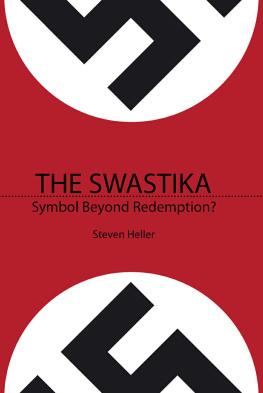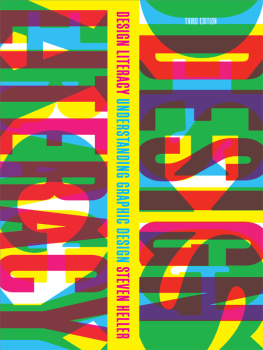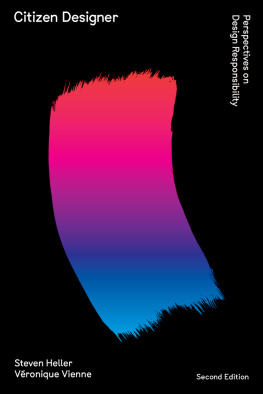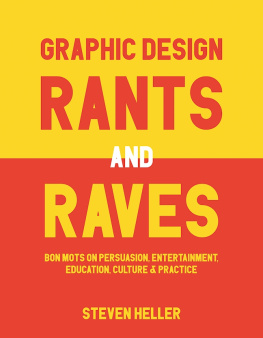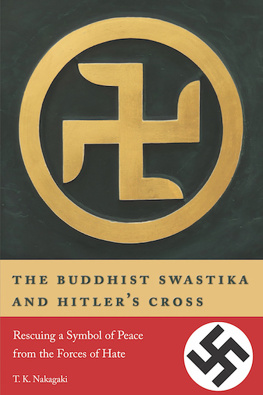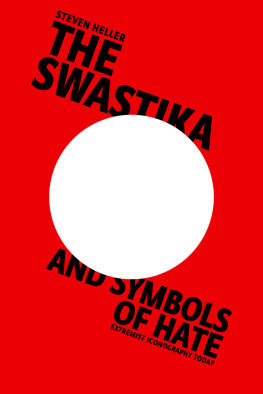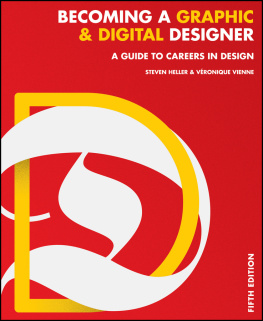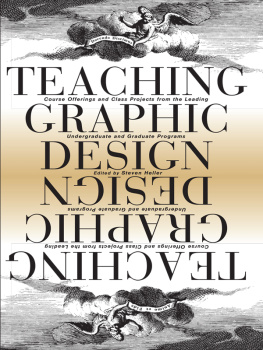Steven Heller - The Swastika: Symbol Beyond Redemption?
Here you can read online Steven Heller - The Swastika: Symbol Beyond Redemption? full text of the book (entire story) in english for free. Download pdf and epub, get meaning, cover and reviews about this ebook. City: New York, year: 2000, publisher: Allworth Press, genre: History. Description of the work, (preface) as well as reviews are available. Best literature library LitArk.com created for fans of good reading and offers a wide selection of genres:
Romance novel
Science fiction
Adventure
Detective
Science
History
Home and family
Prose
Art
Politics
Computer
Non-fiction
Religion
Business
Children
Humor
Choose a favorite category and find really read worthwhile books. Enjoy immersion in the world of imagination, feel the emotions of the characters or learn something new for yourself, make an fascinating discovery.
- Book:The Swastika: Symbol Beyond Redemption?
- Author:
- Publisher:Allworth Press
- Genre:
- Year:2000
- City:New York
- Rating:3 / 5
- Favourites:Add to favourites
- Your mark:
- 60
- 1
- 2
- 3
- 4
- 5
The Swastika: Symbol Beyond Redemption?: summary, description and annotation
We offer to read an annotation, description, summary or preface (depends on what the author of the book "The Swastika: Symbol Beyond Redemption?" wrote himself). If you haven't found the necessary information about the book — write in the comments, we will try to find it.
The Swastika: Symbol Beyond Redemption? — read online for free the complete book (whole text) full work
Below is the text of the book, divided by pages. System saving the place of the last page read, allows you to conveniently read the book "The Swastika: Symbol Beyond Redemption?" online for free, without having to search again every time where you left off. Put a bookmark, and you can go to the page where you finished reading at any time.
Font size:
Interval:
Bookmark:



2000, 2008 Steven Heller
All rights reserved. Copyright under Berne Copyright Convention, Universal Copyright Convention, and Pan-American Copyright Convention. No part of this book may be reproduced, stored in a retrieval system, or transmitted in any form, or by any means, electronic, mechanical, photocopying, recording, or otherwise, without prior permission of the publisher.
12 11 10 09 08 05 04 03 02 01 00
Published by Allworth Press
An imprint of Allworth Communications
10 East 23rd Street, New York, NY 10010
Cover design by Mirko Ilic, New York, NY
Original interior concept by Mirko Ilic, New York, NY
Page composition/typography by Sharp Des!gns, Lansing, MI
LIBRARY OF CONGRESS CATALOG-IN-PUBLICATION DATA
Heller, Steven
The Swastika: a symbol beyond redemption? / Steven Heller.
p. cm.
Includes bibliographical references and index.
ISBN-10: 1-58115-507-7 (paperback)
ISBN-13: 978-1-58115-507-5 (paperback)
1. SwastikaHistory. I. Title.
BL604.S8 H45 2000
302.2223dc21
99-087040
Contents
Acknowledgements
Originally this book was turned down by a number of publishers, so I decided to publish it myself. Two people dissuaded me: One, Mirko Ilic, who designed the cover and the original format, believed that a limited print run and even smaller distribution would not do justice to the subject and urged me to reconsider. He then worked closely on the preliminary aspects of the presentation. The other, Tad Crawford, publisher of Allworth Press, who has always been supportive, was excited by this project from the moment I approached him and threw his full support behind it. Thank you both.
The research required much time and effort uncovering long-lost documents and rare artifacts. Much gratitude goes to Jeff Roth, my chief researcher, without whom there would be no book. Thanks also to Vicki Gold Levi, who helped locate some of the many objects shown throughout. In addition, knowing of my obsession, the following friends have provided valuable materials for my use: Art Chantry, Seymour Chwast, Sue Coe, Dr. James Fraser, Sybille Fraser, Christoph Neimann, Steven Guarnaccia, Rick Poynor, J. J. Sedelmaier, Victor Margolin, Nina Subin, James Victore, Art Speigelman, and Mark Podwal.
A few of the essays herein originated in different forms in other publications. I want to thank these editors for their support and encouragement: Martin Fox of Print, Julie Lasky, formerly of Print , and Neil Feinman, formerly of Speak .
I am also indebted to Eliot Weinberger for his careful reading of this manuscript and important suggestions.
Finally, thanks to Nicole Potter, Jamie Kijowski, and Anne Hellman, editors, and Bob Porter, Associate Publisher, at Allworth Press for their continued efforts on behalf of this book, and to Charlie Sharp at Sharp Des!gns, who skillfully finessed the final page design.
chapter one
SYMBOL BEYOND REDEMPTION?

In a solemn ceremony, representatives of four Arizona Indian tribes, resentful at Nazi sets of oppression, forswore use of the swastika design in native basket and blanket weaving. The Indians placed a blanket, a basket, and some hand-decorated clothing, all bearing swastikas, in a pile, sprinkled them with colored sand and set them afire.
The New York Times , February 29, 1940
The swastika holds a special fascination for graphic designers, like myself, who work with trademarks and logos all the time. After all, it is one of the most visually powerful symbols ever devised. Just set aside for a moment what is known about it and compare the swastika to other great signs of the past and present: No other marknot even variations of the cross or, for that matter, the Nike swooshare as graphically potent. Like most effective symbols, the swastikas geometric purity allows for legibility at any size and distance, and when on its axis, the whirling square gives the illusion of movement. Like a propeller, its hooked edges cut through any surface on which it appears. And because of this, when we return to the swastikas significance during the twentieth century, it also cuts right through the heart.
The swastikas sublime form wed to its wicked function has stimulated considerable inquiry into its origins and its future. The fact that an ignominious fanatic placed a swastika on his battle flag is insufficient reason for ignoring this symbols historic significance, wrote the industrial designer Henry Dreyfuss in Symbol Sourcebook: An Authoritative Guide to International Graphic Symbols (John Wiley & Sons, 1997). Indeed, much has been written about the swastikas rhetorical metamorphosis from a token of good fortune into the emblem of Nazi Germanyas well as its continued use by hate groups throughout the world. The very currency of the swastika makes it a subject for fierce debate.
Today, simply uttering the word swastika evokes revulsion, indeed terror, in many. Yet by all accounts, throughout most of its long history, the swastika, the Zelig of all symbols, was comparatively benign. Prior to its transfiguration, it served as religious phylactery, occult talisman, scientific symbol, guild emblem, meteorological implement, commercial trademark, architectural ornament, printing fleuron, and military insignia.

Look magazine cover. Charlie Chaplin as the Great Dictator wearing the sign of the double cross, 1940.
In the first instance probably the swastika may have represented the course of the sun in the heavens revolving normally from left to right, wrote H. J. D. Astley in The Swastika: A Study ( The Quest , 1925). The swastika also symbolized light or the god of light, forked lightning, rain, and water. It is believed to be the oldest Aryan symbol and has been established as a Jain icon typifying animal, human, and celestial life. It represents Brahma, Vishnu, and SivaCreator, Preserver, Destroyer. It appears in the footprints of Buddha, engraved upon the solid rock of the mountains of India. It stood for Jupiter Tonans and Pluvius of the Latins, and Thor of the Scandinavians. It is said to have had a relationship to the Lotus sign of Egypt and Persia. It appears on the Necropolis of Koban in the Caucasus. It has had a phallic meaning and has been recognized as representing the generative principle of mankind, making it the symbol of the female. Its appearance on monuments to the goddesses Artemis, Hera, Demeter, Astarte, and the Chaldean Nana gives it credence as a sign of fertility.
Its roots dig into deep regions of prehistory and emerge in antiquity. In 1874, Dr. Heinrich Schliemann discovered swastika decorations during his archeological excavation of Homers Troy. He later traced similar iterations to, among other realms, Mycenae, Babylonia, Tibet, Greece, Ashanti on the Gold Coast of Africa, Gaza, Lapland, Paraguay, and Asia Minor. It was discovered painted or etched into Etruscan pottery, Cyprian vases, and Corinthian coins. Schliemann claimed that as described in Ezekiel 9:4, the swastika was similar to the ancient Hebrew letter tau, the sign of life, which was ritualistically written on the forehead of its believers (the reason given for why cult killer Charles Manson had a swastika carved into his forehead). During the Gallico-Roman period, the spindle-whorla swastika by any other namewas found on stone pedestals and altars. In England and Scotland, it was known as the fylfot (as in many feet), and was the embodiment of good fortune and auspicious beginnings. A large mosaic swastika ornamented an ancient synagogue floor in Israel. A copper swastika was unearthed in the nineteenth century at Native American sites: Hopewell Mound in Ross County, Ohio, and Toco Mound in Monroe County, Tennessee.
Next pageFont size:
Interval:
Bookmark:
Similar books «The Swastika: Symbol Beyond Redemption?»
Look at similar books to The Swastika: Symbol Beyond Redemption?. We have selected literature similar in name and meaning in the hope of providing readers with more options to find new, interesting, not yet read works.
Discussion, reviews of the book The Swastika: Symbol Beyond Redemption? and just readers' own opinions. Leave your comments, write what you think about the work, its meaning or the main characters. Specify what exactly you liked and what you didn't like, and why you think so.

